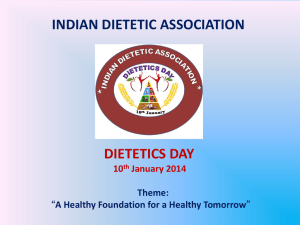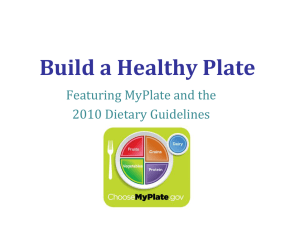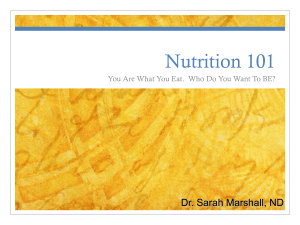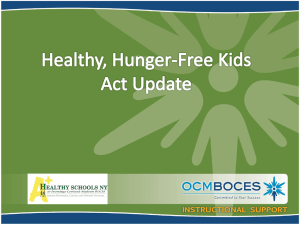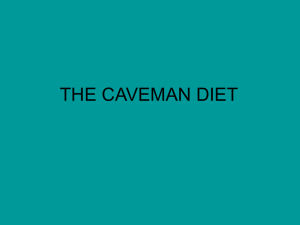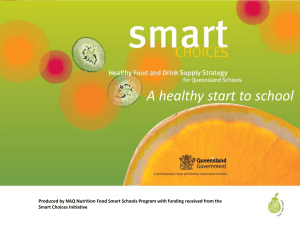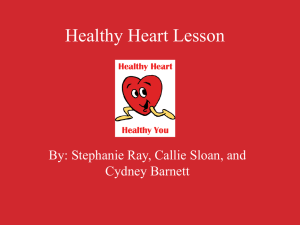The NEEDNT Food List
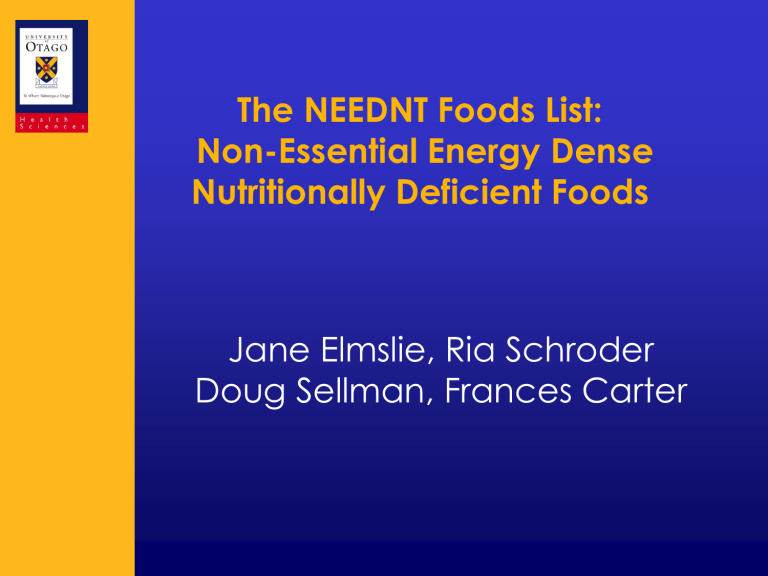
The NEEDNT Foods List:
Non-Essential Energy Dense
Nutritionally Deficient Foods
Jane Elmslie, Ria Schroder
Doug Sellman, Frances Carter
What is the NEEDNT Foods
List?
• A list of 50 non-essential, energy dense, nutritionally deficient foods
• Key money makers for the food industry
• Foods high in fats and added sugars, which together with salt, are the food components most commonly associated with food addiction
Why was it developed?
• Need identified from :
– Clinician and consumer focus groups
– WW vs OA study
– Desire to test abstinence/moderation paradigm without compromising nutritional health
– Lack of movement on traffic light labelling
Clinician and Consumer
Perspectives of Obesity
• Lifestyle change crucial
• Confusing/misinformation unhelpful
• Treatment must address the emotional component of overeating
• Addictive component should be acknowledged. A role for abstinence?
Weight Watchers vs Overeaters
Anonymous
Methodology
• 27 obese participants
• Attended 6 WW meetings and 6 OA meetings
• Randomized order
• Asked what they thought of them?
• Asked what they thought about the concept of “problem food”?
Weight Watchers vs Overeaters
Anonymous (n=27)
• Majority not satisfied with either
• WW – “too structured”, “too complex”,
“become obsessed by counting points”, “not sustainable”, “too commercial – too much hard sell of products”
• OA – “I’m not as bad as them”, “not comfortable with the Higher Power”, “not practical enough” “too touchy feely” suggesting that differences between OA &
WW go beyond abstinence vs moderation
• All able to identify 3-4 problem foods
• Problem foods only part of the problem
What to do now?
• Simplify
• Clarify which foods contain empty calories
• Encourage healthy eating
Medscape News July 19
th
2011
• “Each day, the average American adult consumes roughly 22 teaspoons, 90 g, or 355 calories, of added sugars, well above health guidelines.
Caloric sweeteners in beverages are a key source of excess calories.”
• “New U.S. dietary guidelines recommend drinking water instead sugary drinks. Food and beverage companies say they are being unfairly singled out.”
• “At various times, states and localities have considered taxing sugary beverages to cover obesity-related health costs.”
• In 2009 and 2010, as such proposals became more frequent, the ABA, Coke and Pepsi collectively spent $60 million on lobbying, up from $8 million in
2007 and 2008, according to data collected by the
Center for Responsive Politics' OpenSecrets.org.”
Nutrient composition of Griffins Toffee Pops
Component Qty Per 1 biscuit Qty Per 100g
Energy
Protein
Fat, Total
Fat - Saturated
Carbohydrate, Total
340kJ
0.75g
3.9g
2.5g
10.8g
2000kJ
4.5g
22.8g
14.7g
63.4g
Carbohydrate - Sugar 6.9g 40.2g
Sodium 45mg 270mg
Nutrient composition of Uncle Toby’s Chewy Muesli Bars
Component Qty Per Serving (1 bar) Qty Per 100g
Energy
Protein
Fat, Total
Fat - Saturated
Carbohydrate, Total
Carbohydrate - Sugar
Dietary Fibre
Sodium
540kJ
1.8g
4.2g
1.4g
19.6g
6.6g
2.1g
5mg
1710kJ
5.7g
13.4g
4.5g
62.7g
21g
6.6
15mg
Barriers to change in clinical practice
• “But aren’t sugar and fat the same thing?”
• “The citrus slice saga”
• “I’m having muesli bars now”
10
Developing the list
• Compiled using:
– National Heart Foundation and Diabetes New
Zealand “Foods to Avoid”, “Stop Eating” and
“Optional Foods” lists
– CDHB “Supermarket Shopping Guide”
– USDA population guidance on discretionary calories.
• Foods and beverages were included if they:
– contained alcohol,
– saturated fat,
– added sugar,
– were prepared using a high fat cooking method
– contained a large amount of energy relative to their essential nutrient value.
NON-ESSENTIAL ENERGY-DENSE NUTRITIONALLY-DEFICIENT FOODS
NEEDNT FOOD
Alcoholic drinks
Biscuits
Butter, lard, dripping or similar fat (used as a spread or in baking/cooking etc.)
Cakes
Chocolate
Coconut cream
Condensed milk
Cordial
Corn chips
Cream (including crème fraiche)
Crisps (including vegetable crisps)
Desserts/puddings
Doughnuts
Drinking Chocolate, Milo etc.
Energy drinks
Flavoured milk/milkshakes
Fruit tinned in syrup (even lite syrup!)
REPLACE WITH:
Water/diet soft drinks
*
Lite margarine or similar spread or omit
*
*
Lite coconut milk/coconut flavoured lite evaporated milk
*
Sugar free cordial
*
Natural yoghurt (or flavoured yoghurt
*
* depending on use)
*
Cocoa plus artificial sweetener
Water
Trim, Calcitrim or Lite Blue Milk
Fruit tinned in juice/artificially sweetened
NON-ESSENTIAL ENERGY-DENSE NUTRITIONALLY-DEFICIENT FOODS
NEEDNT FOOD
Fried food
Frozen yoghurt
Fruit juice (except tomato juice and unsweetened blackcurrant juice)
Glucose
High fat crackers (≥ 10g fat per 100g)
Honey
Hot chips
Ice cream
Jam
Marmalade
Mayonnaise
Muesli bars
Muffins
Nuts roasted in fat or oil
Pastries
Pies
Popcorn with butter or oil
REPLACE WITH:
Boiled, grilled or baked food
Ordinary yoghurt
Fresh fruit (apple, orange, pear etc. + a drink!)
*
*
Artificial sweetener
Lower fat crackers (≤ 10g fat per 110g)
*
*
*
Lite dressings/lite mayonnaise
*
*
Dry roasted or raw nuts (≤ 1 handful per day)
*
*
Air popped popcorn
NON-ESSENTIAL ENERGY-DENSE NUTRITIONALLY-DEFICIENT FOODS
NEEDNT FOOD
Quiches
Reduced cream
Regular luncheon sausage
Regular powdered drinks (e.g. Raro)
Regular salami
Regular sausages
Regular soft drinks
Rollups
Sour cream
Sugar (added to anything including drinks, baking, cooking etc.)
Sweets/lollies
Syrups such as golden syrup, treacle, maple syrup
Toasted muesli and any other breakfast cereal with ≥ 15g sugar per 100g cereal
REPLACE WITH:
Crust-less quiches
Natural yoghurt
Low fat luncheon sausage
Water/Diet/Sugar free powdered drinks
Low fat salami
Low fat sausages
Water/Diet soft drinks
Fresh fruit
Natural yoghurt
Artificial sweetener
*
Artificial sweetener
Whole Milk
Yoghurt type products with ≥ 10g sugar per
100g yoghurt
Breakfast cereal with <15g sugar per
100g cereal, > 6g fibre per 100g cereal and <5g fat per 100g cereal (or <10 g fat per 100g cereal if cereal contains nuts and seeds)
Trim, Calcitrim or Lite Blue Milk
Yoghurt (not more than one a day)
Feedback to Date
• Current research participants
– Appreciate the clarity
– Have been surprised at some inclusions
– Useful as an individual guide to work out own most problematic areas
– Useful to choose 5-10 most problematic NEEDNT foods to stop eating completely or focus on reducing significantly
– Gives additional focus beyond portion size
• Current patients
– Appreciate the clarity
– Have expressed the view that they are “addicted” to some foods on the list
– Have used the list to prioritise non essential energy dense food consumption.
– Have achieved their weight loss goals
Feedback to Date
• Colleagues working in obesity treatment
– Think the list is a valuable tool
– Would like to use it with their clients
– Agree with the items included on the list
• Medical Students
– Helps reduce confusion
– Makes sense
– Easy to use and talk about
• Members of Overeaters Anonymous
– What they would refer to as ‘top shelf’ food
– OA members in recovery would never eat any of these foods
Where to from here
Obesity Treatment
– Simple tool to help health professionals initiate conversations about food consumption patterns which may promote and maintain obesity
Research
– Abstinence vs. Moderation – appropriate list of foods to test this paradigm
– Kia Akina – a new concept for participants to contemplate/try in their weight loss journey
– NEEDNT Food List Moderation Guidelines
– NEEDNT Food List FFQ
Acknowledgements
• Ria Schroder
• Doug Sellman
• Frances Carter
• Jim Mann
